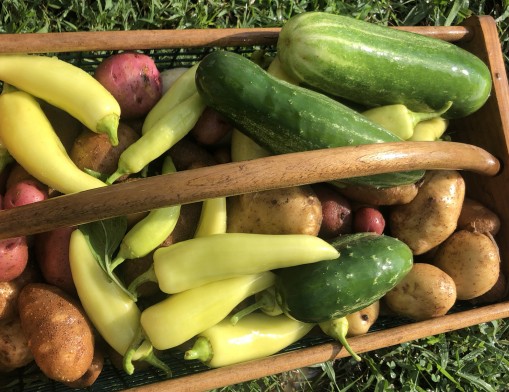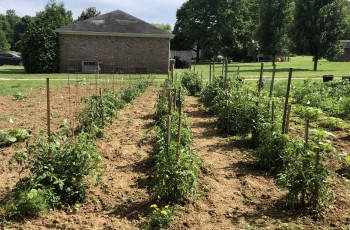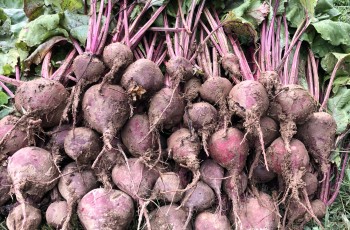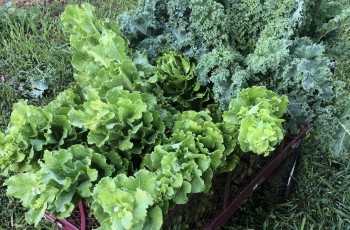Gardening 101
By: Chris Putman | Category: Lawn & Garden | Issue: March 2020

The weather is turning warm, and the desire to work in the open air is on the minds of outdoor enthusiasts. For those who enjoy the reward of reaping a bounty at the end of their labor, it’s the time of year to get started working the soil. Whether a master gardener or a greenhorn who would like to give vegetable gardening a first try, there are some important steps to follow and trial and error is usually the best teacher.
A colorful crop at the end of the season is well worth the effort. The return on investment for the cost of seeds, pesticides, and fertilizer pays off in groceries. Often the harvest can be more than a family can eat during the summer or can or freeze for winter months. What’s more, the flavor that comes from hothouse vegetables can’t hold a candle to the produce that comes straight from the garden to the plate.
When to plant:
So how does a novice get started with planting their first garden? It’s March. Is it too early to start? Tulsa cold snaps range from a last frost date of April 6 to a first frost date of Oct. 24. Any planting that takes place between those two dates should be safe for any tender young start.
Where to plant:
Pick a garden site that is flat, has good drainage, and in full or partial sun. Partial shade is doable, but full shade may mean certain death for young plantings. A faucet for a garden hose should be in proximity to the garden. Also, select an area that is away from the competition, trees and shrubs. These are big competitors for moisture in the soil and will suck the dampness right out of a garden if located nearby. If a gardener finds the prospective garden site has thin soil, then a raised bed might be a better environment for plant growth.

Plan the work, then work the plan:
Group like plants together, such as warm weather plants together and cool weather plants together. This makes for ease of caring for them. Cool-season plants can be planted earlier in the year when average temperatures are around 70-72 degrees while warm weather plants can be planted a little later in the season when temperatures range from 70-90 degrees. The Urban Farmer’s online newsletter has a chart at https://www.ufseeds.com/learning/garden-planting-guide/ that can guide any grower. Gardeners should do their homework when to plant specific seeds. Direct sowing can be done with low maintenance corn, carrot, bean, cucumber, pea, radish and pumpkin seeds, but start inside with tomatoes and peppers. Water is all that is needed during the stage before transplanting to the outside garden. Once young plants are transplanted into the ground, mist them frequently during that first week. This helps the root system to become established in their new environment. After that initial introduction phase, water less often but more thoroughly.
Troubleshoot garden dilemmas:
Urban Farmer can also help a beginner to troubleshoot what’s going awry in most any garden.
Many novices see their seeds stall and not germinate and often think they have bad seeds. Not so much. It is usually an environmental problem. The list of causes sounds like the story of the three bears, “My porridge is too hot; my porridge is too cold.” Same with the soil. It can be too hot, too cold or even too wet for sowing. It also may be as simple as the insects ate the seed. Solution: Pay close attention to planting times to catch the soil at the optimum temperature. Also, don’t overwater.
Another common garden issue is that tender seedlings wilt and die. Again, with the three bears, the soil can be too wet, too dry, too much fertilizer was used, and burned up the plant or the garden had a visitation from insects. Solution: Don’t get distracted with a busy schedule, and allow plants to dry out, avoid overwatering, and realize plants don’t need fertilizer for the first month. Pesticides usually take care of pests if caught early.
Yellow leaves are another problem often found in a garden. It means the plant is not getting enough light or that the soil is deficient in nutrients. Tomato plants are usually the first to display this symptom, but it can be found on other vegetation as well. Solution: Move the plants to receive more sun and test the soil. Test the soil? How can that be done? The OSU Extension Center has a helpful handout to provide growers step-by-step instructions on what to do at https://www.tulsamastergardeners.org/lawn--garden-help/ewExternalFiles/soil%20test%20instructions.pdf. Allow two to three weeks to receive test results.
Slow plant growth can be frustrating for gardeners, especially for enthusiastic new ones. The first thought is that this issue may have been triggered by the shock of being transplanted from an inside environment to an outside one. Low light, cool temperatures, poor quality soil, or pests may be the problem. Solution: The same song and verse, as mentioned for other issues, move the plant to receive more sunlight. Also, cover plants when the temps dip or add a little fertilizer or pesticide.
Tips for growing success:
The OSU Oklahoma Cooperative Extension Services at http://pods.dasnr.okstate.edu/docushare/dsweb/Get/Rendition-3600/unknown provides a planting guide and encourages gardeners to avoid common mistakes novice gardeners make:
- Avoid placing plants so close together that the gardener can’t walk about or work in the garden
- Don’t apply fertilizer directly in contact with plant roots or seeds
- Never oversaturate when watering so that the soil becomes soggy
- Avoid allowing weeds to grow large and overtake the garden before pulling them
- Don’t apply pesticides without thoroughly reading application instructions
- Never use sprays that are not intended for a garden
- Avoid storing diluted sprays for later use
JP Jones is a web and graphic designer with a publishing business as well as a website solutions business. Don’t let that artistic talent brand her as a fussy artist. This young woman has no problem getting her hands dirty and is a master gardener that produces enough food to feed her family, friends, neighbors, church family, and then fill her hometown’s food pantry. So, what caused Jones to get into gardening? She was seeking a distraction to melt away the stress of the day.
“I spend my day behind a computer screen,” Jones said. “I need a tactile activity to reset my creativity, and gardening has become my dirt therapy.”
Jones is more than just an expert in design; she is well-trained and qualified for gardening with her 4-H Extension Office Master Gardener’s certificate, a gardening guru of sorts. The Extension offices offer a program that covers detailed information, and Jones found the course to be an incredible tool to add to her arsenal. She boasts the resources and guest speakers covered all things gardening from soil prep to herbal recipes.
Jones lives in a rural area where there’s a gardener on every block. She’s gleaned a lot of wisdom from exchanging tips with these masters. She learned from these seasoned notables that adding Epson salt to the root of tomato plants is a real plus and how to make her own pesticides so plants can be ranked as 100% organic.
“As the crops keep rolling—and I can no longer face another summer squash or tomato—I will load up a box and take it to local food banks,” Jones said. “They are always thrilled to get fresh produce, and knowing that the food I grew is helping someone that is having a rough time motivates me to plant one more row next year, which leads to my garden getting bigger and bigger and bigger.”
Visiting the Tulsa Country 4-H Extension site at https://www.tulsamastergardeners.org/index.html can provide area residents with a wealth of information. Lunch & Learn events are available in both spring and fall, where Tulsa County Master Gardeners speak and share their experience and tips with those in attendance. Urban Gardener Training, which covers a variety of topics from gardening, trees and shrubs to lawn care, runs from March 5 through April 9. Details can be found at https://www.tulsamastergardeners.org/classes-and-events/urban-gardener-/index.html.
“Our mission is to bring the research-based information from Oklahoma State University out to the people into the communities where they live to help improve their quality life,” Tulsa County OSU Extension Service Director Tracy Lane McKaughan said. “We’re here to extend the university to the people.”
The extension office staff hopes to prove themselves to be “proven, practical and priceless” to the people of the area. The OSU Extension Office is located at 4116 E. 15th Street in Tulsa and can be reached at (918) 746-3701.


Gardening - Value News
For more information, contact:
Value News
918-828-9600 | Fax: 918-828-9933
eat0@eau0eav0eaw0
P.O. Box 35525 | Tulsa, OK 74153
valuenews.com
![]()
![]()
![]()
![]()
![]()
Subscribe
For Free!
